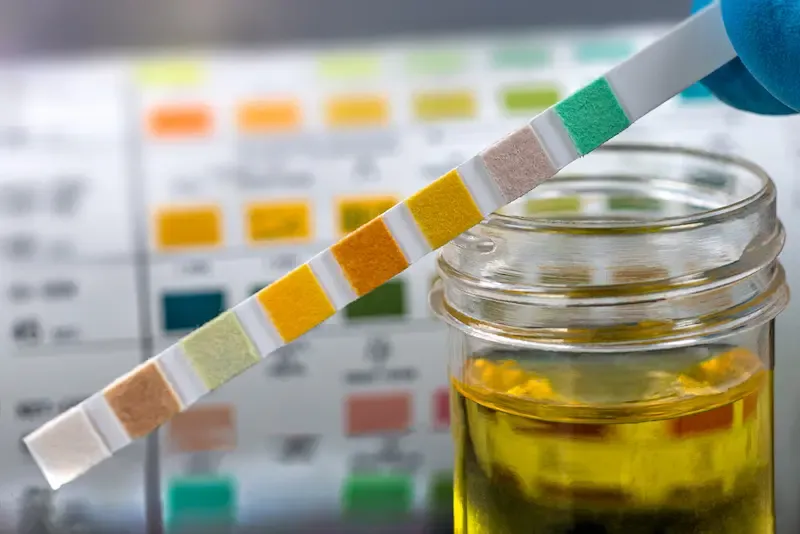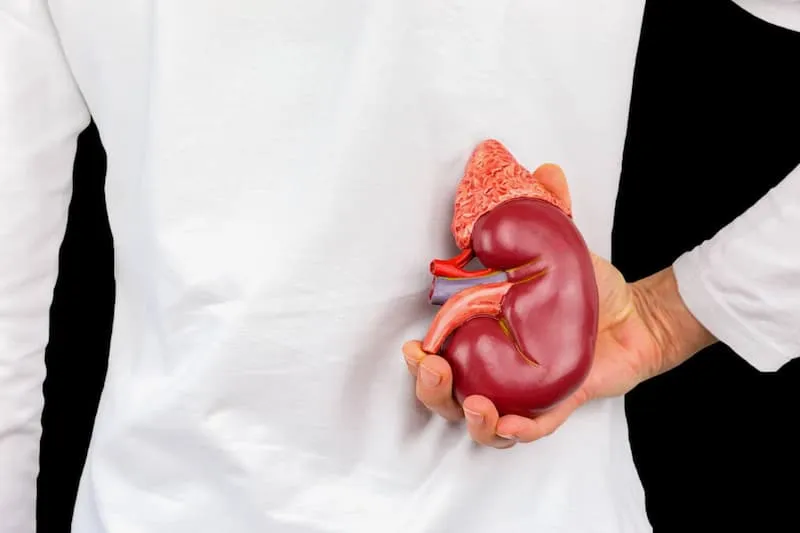Kidney stones, a common urinary tract disorder affecting millions worldwide, can strike without warning and cause significant discomfort. Characterized by hard mineral deposits forming inside the kidneys, these stones often lead to excruciating pain when left untreated. Understanding the symptoms of kidney stones is crucial for timely intervention and effective treatment. According to Dr. Lisa Owens from the National Kidney Foundation, “Early detection is vital in managing kidney stone complications and preventing further health issues.”
Recognizing the tell-tale signs can make all the difference between relief and prolonged agony. Symptoms such as sharp pain in the lower back or side not only hint at a potential problem but also indicate the need for professional medical evaluation. With early diagnosis, patients stand a better chance of minimizing future risks associated with this condition. By exploring both common and lesser-known indications of kidney stones, individuals can take proactive steps towards their wellbeing.
Common Symptoms of Kidney Stones
Kidney stones often announce their presence through a distinctive pattern of sharp pain. Typically, individuals experience acute discomfort in the lower back or side that can be severe enough to disrupt daily activities. This pain frequently catches people off guard and is described as excruciating by many who suffer from it. According to Dr. James Lin, a urologist based in Chicago, “Patients often compare this pain to childbirth or being stabbed because of its intensity.” Recognizing this symptom early on is crucial for initiating timely kidney stone treatment.
The intensity and location of the pain associated with kidney stones may change over time. What begins as a sharp pain in the back or side might shift direction, migrating toward the abdomen or groin area. This changing nature of discomfort can be perplexing and distressing for individuals not familiar with abdominal pain causes. Such shifts are common because the stones migrate along the urinary tract during attempts at natural expulsion, causing intermittent blockages along the way.
Another alarming sign that could indicate the presence of kidney stones is blood in urine, medically referred to as hematuria. If noticed upon urination, it should not be ignored; even slight pinkish or reddish discoloration warrants immediate attention from healthcare professionals. Blood appears in urine when stones cause irritation or minor injuries to the inner linings of ureters or bladder walls while passing through them. Identifying these early warning signals and acting on them promptly aids in facilitating proper diagnosis and managing effective treatment strategies quickly.
Lesser-Known Symptoms to Watch For
While many associate kidney stones with sharp pain or blood in urine, some symptoms may be subtler yet significant indicators of their presence. Frequent urination or the urgent need to urinate can suggest a kidney stone moving through the urinary tract. This increased frequency often results from stones obstructing normal urine flow, which irritates the urinary system. Such irregularities may also hint at potential dehydration — a critical risk factor for kidney stones — where insufficient fluid intake leads to more concentrated urine that promotes stone formation.

Nausea and vomiting frequently accompany abdominal discomfort when dealing with kidney stones. These symptoms arise due to the body’s reaction to intense pain caused by blockages and pressure changes within the kidneys or urinary tract. The disruption not only affects nearby organs but can upset your entire digestive system, resulting in these distressing feelings. Hydration and maintenance of a balanced diet can alleviate these issues; however, persistent incidents warrant medical consultation.
Another lesser-known symptom is cloudy or foul-smelling urine, which could signal an infection accompanying a kidney stone episode. As stones travel down the ureters, they might carry bacteria into vulnerable areas, leading to alarming changes in urine’s appearance and scent. Detecting such signs is crucial as it means immediate attention could prevent severe complications like urinary tract infections (UTIs), which hold substantial health risks if neglected. Practicing good hydration remains essential here — flush out bacteria and support overall renal function effectively.
Recognizing these understated symptoms enhances early detection of kidney-related issues; understanding them empowers individuals to seek appropriate care promptly. By being vigilant about hydration levels and dietary habits known as risk factors for kidney stones, there’s reduced likelihood of ignoring tell-tale signs pointing towards this painful condition.
Identifying Kidney Stone Types Through Symptoms
Kidney stones come in various types and are often identified by specific symptoms, with calcium oxalate stones being the most common. These stones are notorious for causing severe pain in the back or side due to their sharp edges. Other types, such as uric acid stones, might result from a different set of dietary habits and therefore manifest unique symptoms. For instance, those experiencing passing kidney stones symptoms might notice more subtle waves of discomfort if dealing with struvite stones. The nature of the pain could offer clues about what type of stone is present.
Dietary choices play a crucial role in shaping the symptom presentation of kidney stones. High intake of oxalate-rich foods like spinach and nuts can contribute to calcium oxalate stone formation, potentially leading to pronounced back or side pain when they move through the urinary tract. Alternatively, a diet rich in purines — found in red meat and seafood— might result in uric acid stones that don’t necessarily cause immediate severe discomfort but could still lead to noticeable changes in urine color or frequency.
Family history further influences both susceptibility and symptom existence regarding kidney stones. Genetic predisposition can dictate which type one is more likely to develop; knowing family medical history might indicate particular signs to monitor closely. For example, if close relatives have experienced passing kidney stone symptoms characterized by intermittent yet intense abdominal pain, individuals should heed similar indicators as potential warnings of familial patterns repeating themselves. Understanding these nuances aids not only in early recognition but also in tailored preventive strategies against recurring episodes.
Risk Factors Associated with Kidney Stones
Dehydration stands as a major risk factor in the development of kidney stones. When the body lacks adequate fluids, there’s insufficient urine production to dissolve and expel minerals and salts that form stones. In regions where hot climates prevail or among individuals with low fluid intake, this problem may be especially pronounced. Hydration is therefore not just a matter of general well-being but a crucial defensive measure; ensuring enough water intake daily can significantly reduce stone formation risks.

Diet plays an essential role in either exacerbating or preventing kidney stones. Foods high in sodium can increase calcium levels in urine, contributing directly to stone formation. This highlights the need for a balanced diet for preventing kidney stones, focusing on reducing salt intake alongside limiting oxalate-rich foods like spinach and nuts, which also contribute to stone development. Also, engaging with dietary guidelines under professional guidance could help mitigate these risks effectively.
Medications are another factor that might increase susceptibility to kidney stones in some individuals. Certain medications, whether prescribed for chronic conditions or over-the-counter options such as high doses of vitamin D supplements or certain antidepressants, have been linked to an increased likelihood of stone formation. Understanding how particular medicines interact with the body’s chemistry can provide critical insights into why someone might suddenly experience symptoms. When considering such factors combined with personal health history, determining when to see a doctor for kidney stones becomes imperative if severe symptoms persist or recur frequently.
When to Seek Medical Attention
Recognizing the need for medical attention in cases of kidney stones can be crucial. Many affected individuals experience severe symptoms often characterized by intense pain, which commands immediate professional evaluation. Pain that is intolerable and does not subside or is accompanied by fever, chills, or vomiting signals a possibly serious condition where quick intervention may prevent further complications. Further, if there is difficulty urinating or noticeable blood in the urine, these are clear indicators that should prompt an urgent consultation with a healthcare provider.

The diagnostic process for kidney stones frequently involves a combination of clinical examination and imaging tests. Commonly used imaging methods include ultrasound and non-contrast CT scans, which efficiently help identify the presence, size, and location of stones within the urinary tract. Additionally, urinalysis provides relevant information regarding infection signs or mineral levels associated with stone formation. With advanced diagnostic tools available today, many healthcare facilities can rapidly confirm suspicions of kidney stones.
Timely intervention plays a pivotal role in managing kidney stones effectively and preventing potential complications such as urinary infections or permanent damage to renal functions. Ignoring persistent symptoms could lead to adverse outcomes that might necessitate more extensive treatments like surgical procedures. Healthcare professionals stress on early diagnosis to enable less invasive treatment options, such as medication or minimally invasive techniques like extracorporeal shock wave lithotripsy (ESWL), known for breaking down stones into smaller passable pieces without surgery.
Home Remedies and Prevention Strategies
Staying hydrated is one of the most effective ways to prevent kidney stones. The Mayo Clinic suggests that drinking enough water to produce about 2.5 liters of urine a day is ideal. This roughly translates to consuming at least 8-10 glasses of water daily, depending on individual needs and activity levels. Lemon water has gained popularity due to its citric acid content, which may help prevent stone formation by breaking down calcium deposits.
Dietary changes can play a vital role in minimizing the recurrence risk of kidney stones. Reducing the intake of sodium-rich foods can help, as high sodium levels increase calcium build-up in the kidneys. Incorporating more fruits and vegetables may be beneficial since they regulate oxalate levels within the body, further reducing risks associated with common types such as calcium oxalate stones.
Natural remedies can also alleviate discomfort during initial symptoms. Some people find relief by sipping herbal teas containing ingredients like nettle leaf or dandelion root, known for their diuretic properties that promote increased urine flow. However, these should complement rather than replace medical advice or treatments from healthcare professionals. As always, consulting with a doctor before trying new remedies ensures safety and appropriateness for any individual’s condition.
Supporting Someone with Kidney Stones
Caregivers play a crucial role in helping individuals manage kidney stone symptoms at home. This support can start with ensuring the patient stays well-hydrated, as adequate fluid intake is essential to facilitate passing the stones. Encouraging them to maintain a balanced diet with low sodium and reduced oxalate foods can also help alleviate discomfort. Additionally, caregivers may assist with administering over-the-counter pain relief medications as advised by healthcare professionals. Providing such practical assistance not only supports physical comfort but also empowers patients to take an active role in managing their health.

Emotional support from caregivers during this challenging time is equally vital. Kidney stones often cause significant pain and can be emotionally taxing, particularly when facing repeated attacks or awaiting treatment decisions. Simple gestures like listening without judgment and offering reassurance during these painful episodes can make a considerable difference. Being present and attentive helps reduce feelings of anxiety and isolation that are common among those dealing with kidney stones.
Education about follow-up care and necessary lifestyle changes post-diagnosis is another critical area where caregivers can offer indispensable support. It involves staying informed about the medical advice given by healthcare providers, including recommended tests or procedures following initial treatments. Caregivers should encourage adherence to any prescribed dietary changes or medication regimens designed to prevent future stone formation. By actively participating in post-treatment care, caregivers contribute significantly to reducing the likelihood of recurrence and promoting long-term kidney health for their loved ones.
Taking Control of Kidney Stone Symptoms
Recognizing the symptoms associated with kidney stones, such as sharp pain in the lower back, changing intensity that may shift to the abdomen or groin, and blood in the urine, is crucial for timely intervention. Lesser-known signs like frequent urination or nausea can also indicate complications. Medical experts stress the importance of seeking medical advice when these symptoms manifest to prevent severe health issues.
Maintaining kidney health through proactive measures is essential for all individuals, especially those at risk. By staying hydrated, adopting dietary changes, and understanding personal and family medical history, people can make informed decisions about their wellness. Early awareness and professional consultation provide a foundation for managing kidney stones effectively and avoiding future recurrences.





